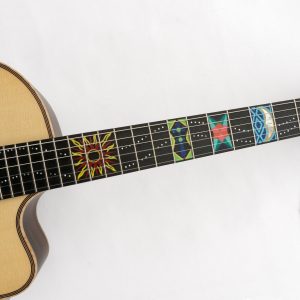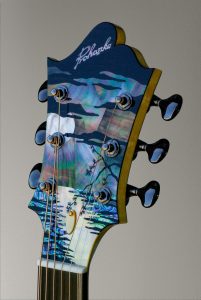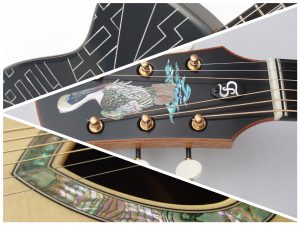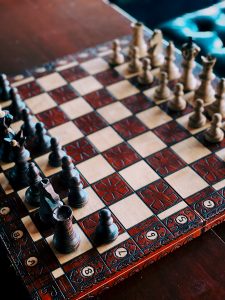Fretboard Inlays
 Wood inlays are frequently used in guitars, particularly in the fingerboards and headstocks. Fretboard inlays are the most common type of inlay used in guitars, and they involve embedding pieces of wood or other materials into the fingerboard to create a pattern or design.
Wood inlays are frequently used in guitars, particularly in the fingerboards and headstocks. Fretboard inlays are the most common type of inlay used in guitars, and they involve embedding pieces of wood or other materials into the fingerboard to create a pattern or design.
Fretboard inlays can be made from various materials, such as different types of wood, abalone, mother-of-pearl, and others. They may feature dots, diamonds, geometric shapes, or more intricate designs like animals, flowers, or vines.
Apart from fretboard inlays, some guitars have inlays on the headstock, which may include decorative elements or the guitar maker’s name.
Creating wood inlays for guitars requires precision and attention to detail, and many guitar makers collaborate with skilled artisans to make custom inlays for their instruments. Some inlays are made by hand using specialized tools, while others use computer-aided design and manufacturing (CAD/CAM) technology.
Overall, wood inlays are an important and visually striking feature of many guitars, adding aesthetic appeal and value to the instrument.
Custom Inlay
Wood inlays are a type of decorative element that involve embedding small pieces of wood into a larger wooden surface to create intricate and visually appealing designs or patterns. Different types of wood can be used to create inlays, including those with contrasting colors or textures, to achieve a striking effect.
There are various types of wood inlays available, such as banding inlays, which are used to decorate the edges of furniture or other wooden surfaces with narrow strips of wood. Marquetry inlays involve creating a design or picture using different colors and types of wood, while parquetry inlays use small pieces of wood arranged in a repeating pattern to form geometric designs.
Banding Inlays
Adding narrow strips of contrasting wood to the edges of a larger wooden surface is known as banding inlays, which has been a decorative element for centuries in the production of furniture, musical instruments, and decorative objects.
To make banding inlays, thin strips of wood are cut to the desired width and thickness and then attached to the edge of the main wooden surface with glue. These strips can be made from the same wood as the main surface or a contrasting wood to create a decorative effect.
Banding inlays can take many forms, including simple lines, geometric shapes, and intricate patterns, and may also include other decorative elements such as metal or stone.
Precision and attention to detail are necessary for creating banding inlays, as the strips of wood must be precisely cut and seamlessly fitted together. The inlays must be sanded and finished to match the main surface, creating a cohesive and integrated appearance.
Banding inlays can add an elegant and sophisticated touch to wooden surfaces and are commonly used in high-end furniture and decorative objects. They also offer the opportunity for unique and personalized designs.
Marquetry Inlays
 Marquetry inlays are a centuries-old woodworking technique that utilizes thin pieces of wood or other materials to create intricate designs and patterns on a larger wooden surface. To create a marquetry inlay, the process typically follows these steps:
Marquetry inlays are a centuries-old woodworking technique that utilizes thin pieces of wood or other materials to create intricate designs and patterns on a larger wooden surface. To create a marquetry inlay, the process typically follows these steps:
- Designing the pattern: The first step is to design the pattern that will be used. This can be done by hand, using a reference drawing, or with the assistance of computer-aided design (CAD) software.
- Cutting the pieces: The next step is to cut the pieces of wood into thin strips, usually no more than 1/8 inch thick. This can be accomplished using a handsaw or a scroll saw.
- Assembling the pattern: The pieces of wood are then arranged to create the desired pattern or design, which may involve cutting them into smaller shapes.
- Gluing the pieces: Once the pattern has been assembled, the pieces are glued onto a larger wooden surface, such as a cabinet door or tabletop. The glue is usually applied to the back of each piece using a small brush.
- Sanding and finishing: After the glue has dried, the inlay is sanded and finished to match the surrounding wood. This can involve using hand sanding and specialized finishing techniques to achieve a smooth and seamless appearance.
Marquetry inlays can be made using a variety of wood species and may incorporate other decorative materials, including mother-of-pearl, bone, or metal. This technique allows for a high degree of customization and artistic expression, making it a popular choice for high-end furniture and decorative objects.
Wood inlays can be applied to various wooden surfaces, including furniture, flooring, and decorative objects, as well as guitars. Skilled artisans typically create these inlays using specialized tools and techniques to achieve intricate and detailed designs.
Other Items Can Be Inlaid
Inlays are not just limited to guitars, mandolins, and violins; they have been used to decorate various musical instruments throughout history. The piano, for instance, commonly features intricate inlay work on the keys, cabinet, and legs. These inlays can be made from various materials, such as wood, ivory, and mother-of-pearl, and can incorporate a wide range of designs, from simple geometric patterns to detailed landscapes and scenes.
The banjo is another instrument that often showcases inlay work on the fingerboard, headstock, and resonator. Banjos with inlay work can be highly decorative, featuring anything from simple dot patterns to intricate images and scenes.
Furthermore, other musical instruments such as mandolins, ukuleles, drums, brass, and wind instruments may also feature inlay work. Inlays can serve to add a decorative element to the instrument, create a unique and customized design, or enhance the instrument’s functionality by creating fret markers on a mandolin or guitar.
Inlaying on musical instruments requires a great deal of precision and expertise to execute, and it can significantly increase the instrument’s value. As a result, musical instruments with inlay work are often highly sought after by collectors and musicians alike.
Inlaid furniture
 Incorporating wood inlays into furniture is a versatile technique that can be applied to many types of pieces, such as tables, cabinets, desks, chairs, and even beds. The intricate designs and patterns created through inlay work not only add a decorative element but can also serve a functional purpose.
Incorporating wood inlays into furniture is a versatile technique that can be applied to many types of pieces, such as tables, cabinets, desks, chairs, and even beds. The intricate designs and patterns created through inlay work not only add a decorative element but can also serve a functional purpose.
This technique has been popular for centuries, and inlaid furniture can be found in various styles and design traditions. In the Baroque and Rococo periods in Europe, inlaid furniture was used to create opulent and ornate designs. In the early 20th century Art Deco era, bold geometric patterns and exotic materials like mother-of-pearl and ebony characterized inlaid furniture.
 Traditional Chinese and Japanese furniture also incorporate inlay work, creating simple yet elegant designs that highlight the wood’s natural beauty.
Traditional Chinese and Japanese furniture also incorporate inlay work, creating simple yet elegant designs that highlight the wood’s natural beauty.
Today, inlaid furniture remains a sought-after choice for those who appreciate the craftsmanship and aesthetics of this traditional technique. From classic to contemporary, inlaid furniture can be made with different wood species and other decorative materials, offering a wide range of styles and options.
Inlays can add a beautiful and unique touch to wooden surfaces and can be used to create both traditional and contemporary styles. Find out more.